gearbox Citroen BERLINGO MULTISPACE RHD 2014 2.G Owner's Manual
[x] Cancel search | Manufacturer: CITROEN, Model Year: 2014, Model line: BERLINGO MULTISPACE RHD, Model: Citroen BERLINGO MULTISPACE RHD 2014 2.GPages: 268, PDF Size: 13.36 MB
Page 4 of 268
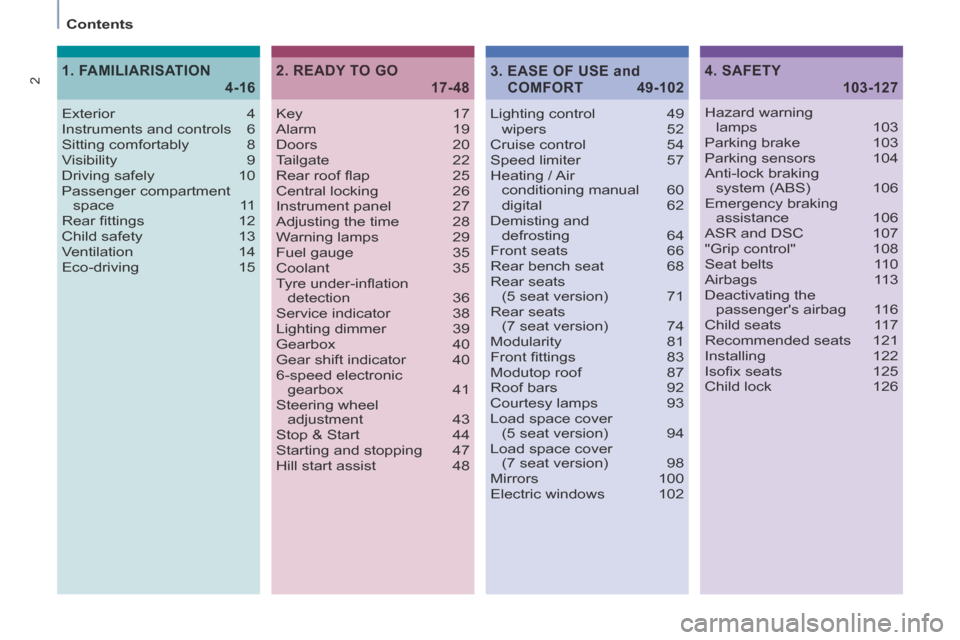
2
Contents Key 17
Alarm 19
Doors 20
Tailgate 22
Rear roof fl ap 25
Central locking 26
Instrument panel 27
Adjusting the time 28
Warning lamps 29
Fuel gauge 35
Coolant 35
Tyre under-infl ation detection 36
Service indicator 38
Lighting dimmer 39
Gearbox 40
Gear shift indicator 40
6-speed electronic gearbox 41
Steering wheel adjustment 43
Stop & Start 44
Starting and stopping 47
Hill start assist 48 Lighting control 49
wipers
52
Cruise control 54
Speed limiter 57
Heating / Air conditioning manual 60
digital 62
Demisting and defrosting 64
Front seats 66
Rear bench seat 68
Rear seats (5 seat version) 71
Rear seats (7 seat version) 74
Modularity 81
Front fi ttings 83
Modutop roof 87
Roof bars 92
Courtesy lamps 93
Load space cover (5 seat version) 94
Load space cover (7 seat version) 98
Mirrors 100
Electric windows 102
2. READY TO GO
17-48
4. SAFETY
103-127
Exterior 4
Instruments and controls 6
Sitting comfortably 8
Visibility 9
Driving safely 10
Passenger compartment space 11
Rear fi ttings 12
Child safety 13
Ventilation 14
Eco-driving 15
1. FAMILIARISATION
4-16
Hazard warning
lamps 103
Parking brake 103
Parking sensors 104
Anti-lock braking system (ABS) 106
Emergency braking assistance 106
ASR and DSC 107
"Grip control" 108
Seat belts 110
Airbags 113
Deactivating the passenger's airbag 116
Child seats 117
Recommended seats 121
Installing 122
Isofi x seats 125
Child lock 126
3. EASE OF USE and
COMFORT 49-102
Page 8 of 268
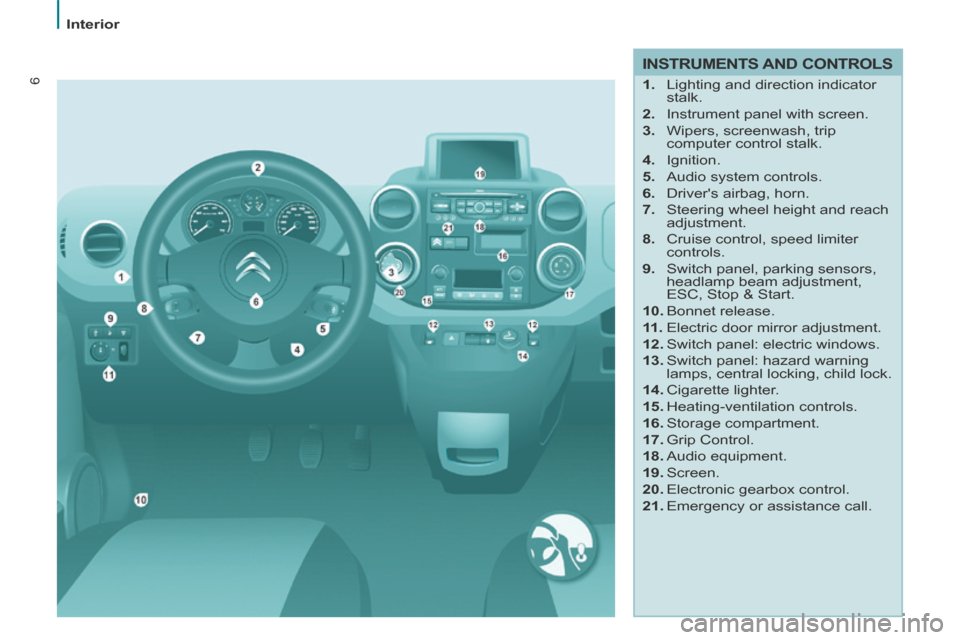
6
Interior
INSTRUMENTS AND CONTROLS
1. Lighting and direction indicator stalk.
2. Instrument panel with screen.
3. Wipers, screenwash, trip computer control stalk.
4. Ignition.
5. Audio system controls.
6. Driver's airbag, horn.
7. Steering wheel height and reach adjustment.
8. Cruise control, speed limiter controls.
9. Switch panel, parking sensors, headlamp beam adjustment,
ESC, Stop & Start.
10. Bonnet release.
11 . Electric door mirror adjustment.
12. Switch panel: electric windows.
13. Switch panel: hazard warning lamps, central locking, child lock.
14. Cigarette lighter.
15. Heating-ventilation controls.
16. Storage compartment.
17. Grip Control.
18. Audio equipment.
19. Screen.
20. Electronic gearbox control.
21. Emergency or assistance call.
Page 9 of 268
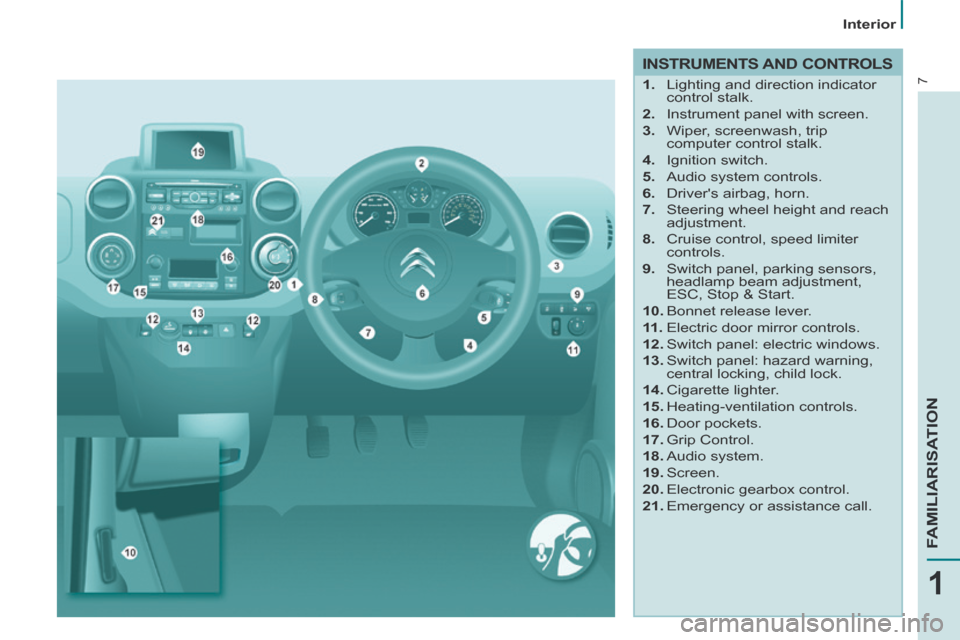
7
1
FAMILIARISATION
Interior
INSTRUMENTS AND CONTROLS
1. Lighting and direction indicator control stalk.
2. Instrument panel with screen.
3. Wiper, screenwash, trip computer control stalk.
4. Ignition switch.
5. Audio system controls.
6. Driver's airbag, horn.
7. Steering wheel height and reach adjustment.
8. Cruise control, speed limiter controls.
9. Switch panel, parking sensors, headlamp beam adjustment,
ESC, Stop & Start.
10. Bonnet release lever.
11 . Electric door mirror controls.
12. Switch panel: electric windows.
13. Switch panel: hazard warning, central locking, child lock.
14. Cigarette lighter.
15. Heating-ventilation controls.
16. Door pockets.
17. Grip Control.
18. Audio system.
19. Screen.
20. Electronic gearbox control.
21. Emergency or assistance call.
Page 17 of 268

15
1
FAMILIARISATION
ECO-DRIVING
Eco-driving is a range of everyday practices that allow the motorist to \
optimise their fuel consumption and CO2
emissions.
Optimise the use of your
gearbox
With a manual gearbox, move
off gently and change up without
waiting. During acceleration change
up early.
With an automatic or electronic
gearbox, give preference to
automatic mode and avoid pressing
the accelerator pedal heavily or
suddenly.
Control the use of your
electrical equipment
Before moving off, if the passenger
compartment is too warm, ventilate it
by opening the windows and air vents
before using the air conditioning.
Above 30 mph (50 km/h), close the
windows and leave the air vents open.
Remember to make use of equipment
that can help keep the temperature
in the passenger compartment down
(sunroof and window blinds...). Switch off the headlamps and front
foglamps when the level of light does
not require their use.
Avoid running the engine before
moving off, particularly in winter; your
vehicle will warm up much faster
while driving.
Drive smoothly
Maintain a safe distance between
vehicles, use engine braking rather
than the brake pedal, and press the
accelerator progressively. These
practices contribute towards a
reduction in fuel consumption and CO
2
emissions and also helps reduce the
background traffi c noise.
If your vehicle has cruise control,
make use of the system at speeds
above 25 mph (40 km/h) when the
traffi c is fl owing well.
As a passenger, if you avoid
connecting your multimedia devices
(fi lm, music, video game...), you
will contribute towards limiting the
consumption of electrical energy, and
so of fuel.
Disconnect your portable devices
before leaving the vehicle. Switch off the air conditioning, unless
it has automatic regulation, as
soon as the desired temperature is
attained.
Switch off the demisting and
defrosting controls, if not automatic.
Switch off the heated seat as soon as
possible.
The gear shift indicator invites you
engage the most suitable gear: as
soon as the indication is displayed in
the instrument panel, follow it straight
away.
For vehicles fi tted with an electronic
or automatic gearbox, this indicator
appears only in manual mode.
Page 36 of 268

Instruments and controls
34
Warning lamp in the
screen is
indicates Solution - action
Cruise
control on.
cruise control selected. Manual selection. Chapter 3, "Steering mounted
controls" section.
Speed limiter on. speed limiter selected. Manual selection. Chapter 3, "Steering mounted
controls" section.
Gear shift
indicator on. a recommendation
independent of the type and
density of traffi c. To reduce fuel consumption, change to an
appropriate gear with a manual gearbox.
The driver retains responsibility to follow this
indication or not.
Diesel pre-
heating on. climatic conditions requiring
pre-heating. Wait until the warning lamp goes off before
operating the starter.
Presence of
water in the
Diesel fi lter
on and
accompanied by
a message in the
screen.
water in the Diesel fi lter. Have the fi lter bled by a CITROËN dealer or a
qualifi ed workshop without delay. Chapter 6,
"Checks" section.
According to country.
Service
spanner on. that a service will be due
shortly. Refer to the list of checks in the maintenance and
warranty guide. Have the service carried out by a
CITROËN dealer or a qualifi ed workshop.
Time fl ashing. adjustment of the time. Use the left-hand button on the instrument panel.
Chapter 2, at the beginning of the "Instruments
and controls" section.
Page 42 of 268
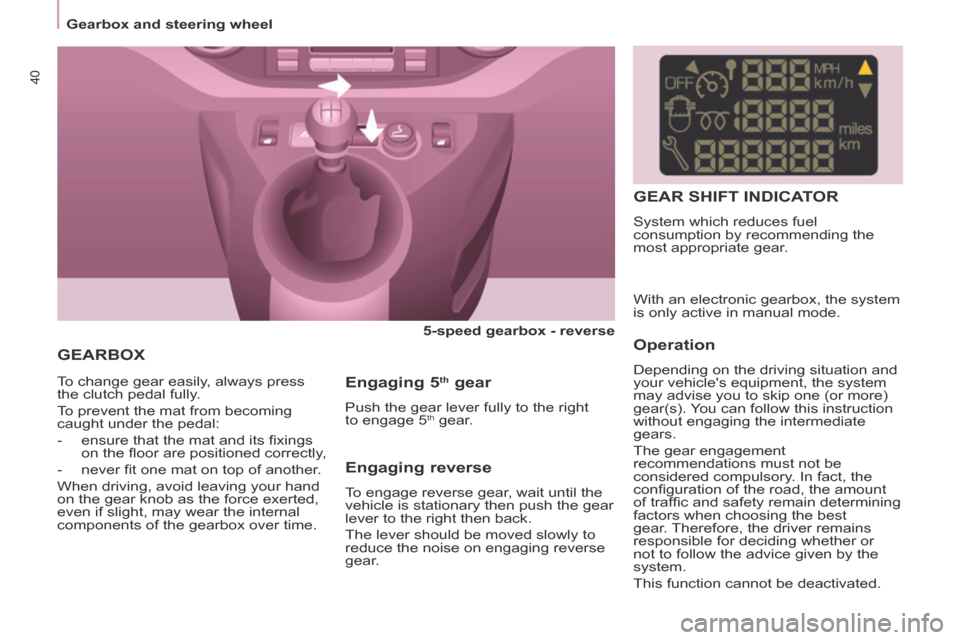
Gearbox and steering wheel
40
GEARBOX
5-speed gearbox - reverse
To change gear easily, always press
the clutch pedal fully.
To prevent the mat from becoming
caught under the pedal:
- ensure that the mat and its fi xings on the fl oor are positioned correctly,
- never fi t one mat on top of another.
When driving, avoid leaving your hand
on the gear knob as the force exerted,
even if slight, may wear the internal
components of the gearbox over time.
Engaging 5 th gear
Push the gear lever fully to the right
to engage 5 th gear. With an electronic gearbox, the system
is only active in manual mode.
GEAR SHIFT INDICATOR
System which reduces fuel
consumption by recommending the
most appropriate gear.
Engaging reverse
To engage reverse gear, wait until the
vehicle is stationary then push the gear
lever to the right then back.
The lever should be moved slowly to
reduce the noise on engaging reverse
gear.
Operation
Depending on the driving situation and
your vehicle's equipment, the system
may advise you to skip one (or more)
gear(s). You can follow this instruction
without engaging the intermediate
gears.
The gear engagement
recommendations must not be
considered compulsory. In fact, the
confi guration of the road, the amount
of traffi c and safety remain determining
factors when choosing the best
gear. Therefore, the driver remains
responsible for deciding whether or
not to follow the advice given by the
system.
This function cannot be deactivated.
Page 43 of 268
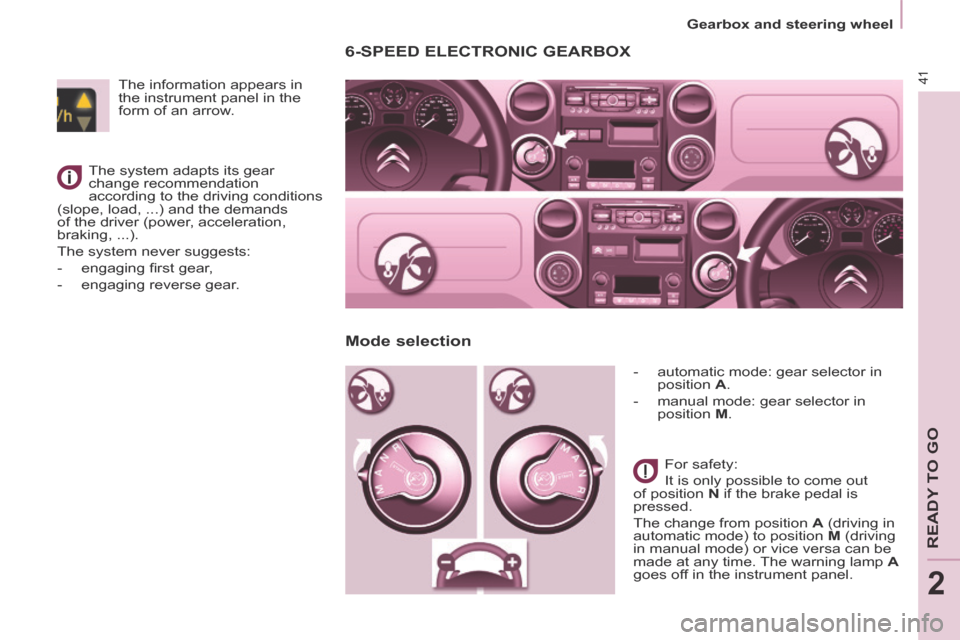
2
Gearbox and steering wheel
41
READY TO GO
6-SPEED ELECTRONIC GEARBOX
- automatic mode: gear selector in position A .
- manual mode: gear selector in position M .
For safety:
It is only possible to come out
of position N if the brake pedal is
pressed.
The change from position A (driving in
automatic mode) to position M (driving
in manual mode) or vice versa can be
made at any time. The warning lamp A
goes off in the instrument panel.
Mode selection
The information appears in
the instrument panel in the
form of an arrow.
The system adapts its gear
change recommendation
according to the driving conditions
(slope, load, ...) and the demands
of the driver (power, acceleration,
braking, ...).
The system never suggests:
- engaging fi rst gear,
- engaging reverse gear.
Page 44 of 268
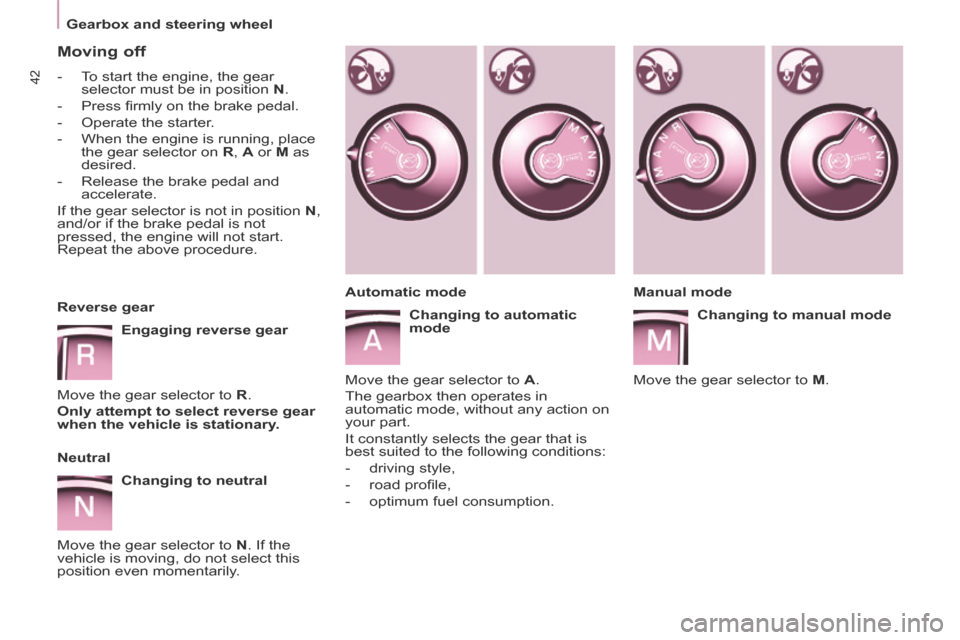
Gearbox and steering wheel
42
Moving off
- To start the engine, the gear selector must be in position N .
- Press fi rmly on the brake pedal.
- Operate the starter.
- When the engine is running, place the gear selector on R , A or M as
desired.
- Release the brake pedal and accelerate.
If the gear selector is not in position N ,
and/or if the brake pedal is not
pressed, the engine will not start.
Repeat the above procedure.
Reverse gear
Engaging reverse gear
Move the gear selector to R .
Only attempt to select reverse gear
when the vehicle is stationary.
Neutral
Changing to neutral
Move the gear selector to N . If the
vehicle is moving, do not select this
position even momentarily. Manual mode
Changing to manual mode
Move the gear selector to M .
Automatic mode
Changing to automatic
mode
Move the gear selector to A .
The gearbox then operates in
automatic mode, without any action on
your part.
It constantly selects the gear that is
best suited to the following conditions:
- driving style,
- road profi le,
- optimum fuel consumption.
Page 45 of 268
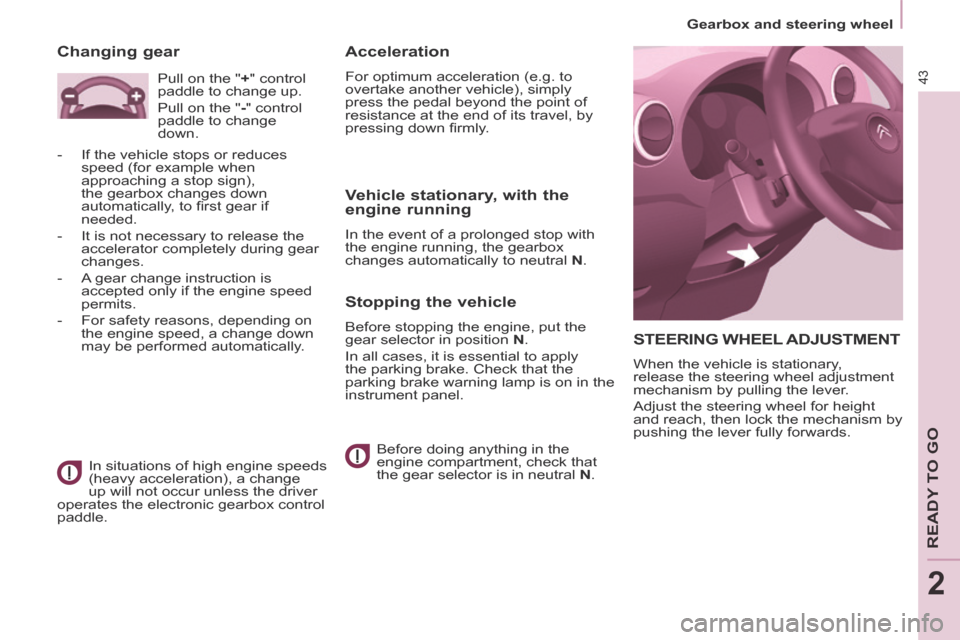
2
Gearbox and steering wheel
43
READY TO GO
STEERING WHEEL ADJUSTMENT
When the vehicle is stationary,
release the steering wheel adjustment
mechanism by pulling the lever.
Adjust the steering wheel for height
and reach, then lock the mechanism by
pushing the lever fully forwards.
Acceleration
For optimum acceleration (e.g. to
overtake another vehicle), simply
press the pedal beyond the point of
resistance at the end of its travel, by
pressing down fi rmly.
Vehicle stationary, with the
engine running
In the event of a prolonged stop with
the engine running, the gearbox
changes automatically to neutral N .
Stopping the vehicle
Before stopping the engine, put the
gear selector in position N .
In all cases, it is essential to apply
the parking brake. Check that the
parking brake warning lamp is on in the
instrument panel.
Before doing anything in the
engine compartment, check that
the gear selector is in neutral N .
Changing gear
In situations of high engine speeds
(heavy acceleration), a change
up will not occur unless the driver
operates the electronic gearbox control
paddle. Pull on the "
+ " control
paddle to change up.
Pull on the " - " control
paddle to change
down.
- If the vehicle stops or reduces speed (for example when
approaching a stop sign),
the gearbox changes down
automatically, to fi rst gear if
needed.
- It is not necessary to release the accelerator completely during gear
changes.
- A gear change instruction is accepted only if the engine speed
permits.
- For safety reasons, depending on the engine speed, a change down
may be performed automatically.
Page 46 of 268
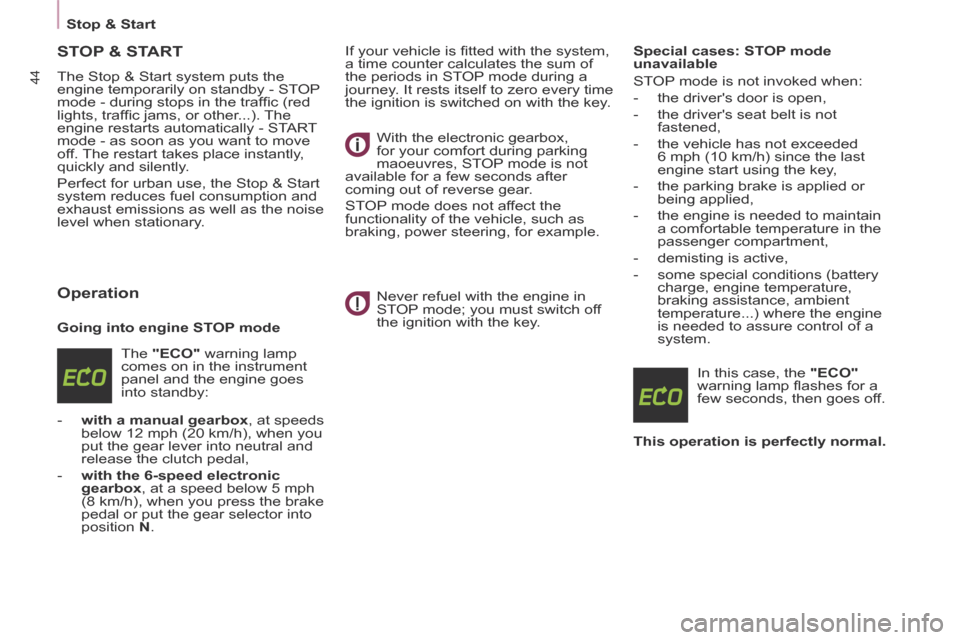
Stop & Start
44
STOP & START
The Stop & Start system puts the
engine temporarily on standby - STOP
mode - during stops in the traffi c (red
lights, traffi c jams, or other...). The
engine restarts automatically - START
mode - as soon as you want to move
off. The restart takes place instantly,
quickly and silently.
Perfect for urban use, the Stop & Start
system reduces fuel consumption and
exhaust emissions as well as the noise
level when stationary.
Operation
Going into engine STOP mode The "ECO" warning lamp
comes on in the instrument
panel and the engine goes
into standby:
- with a manual gearbox , at speeds below 12 mph (20 km/h), when you
put the gear lever into neutral and
release the clutch pedal,
- with the 6-speed electronic gearbox , at a speed below 5 mph
(8 km/h), when you press the brake
pedal or put the gear selector into
position N . If your vehicle is fi tted with the system,
a time counter calculates the sum of
the periods in STOP mode during a
journey. It rests itself to zero every time
the ignition is switched on with the key.
With the electronic gearbox,
for your comfort during parking
maoeuvres, STOP mode is not
available for a few seconds after
coming out of reverse gear.
STOP mode does not affect the
functionality of the vehicle, such as
braking, power steering, for example.
Never refuel with the engine in
STOP mode; you must switch off
the ignition with the key. Special cases: STOP mode
unavailable
STOP mode is not invoked when:
- the driver's door is open,
- the driver's seat belt is not
fastened,
- the vehicle has not exceeded 6 mph (10 km/h) since the last
engine start using the key,
- the parking brake is applied or being applied,
- the engine is needed to maintain a comfortable temperature in the
passenger compartment,
- demisting is active,
- some special conditions (battery charge, engine temperature,
braking assistance, ambient
temperature...) where the engine
is needed to assure control of a
system.
In this case, the "ECO"
warning lamp fl ashes for a
few seconds, then goes off.
This operation is perfectly normal.